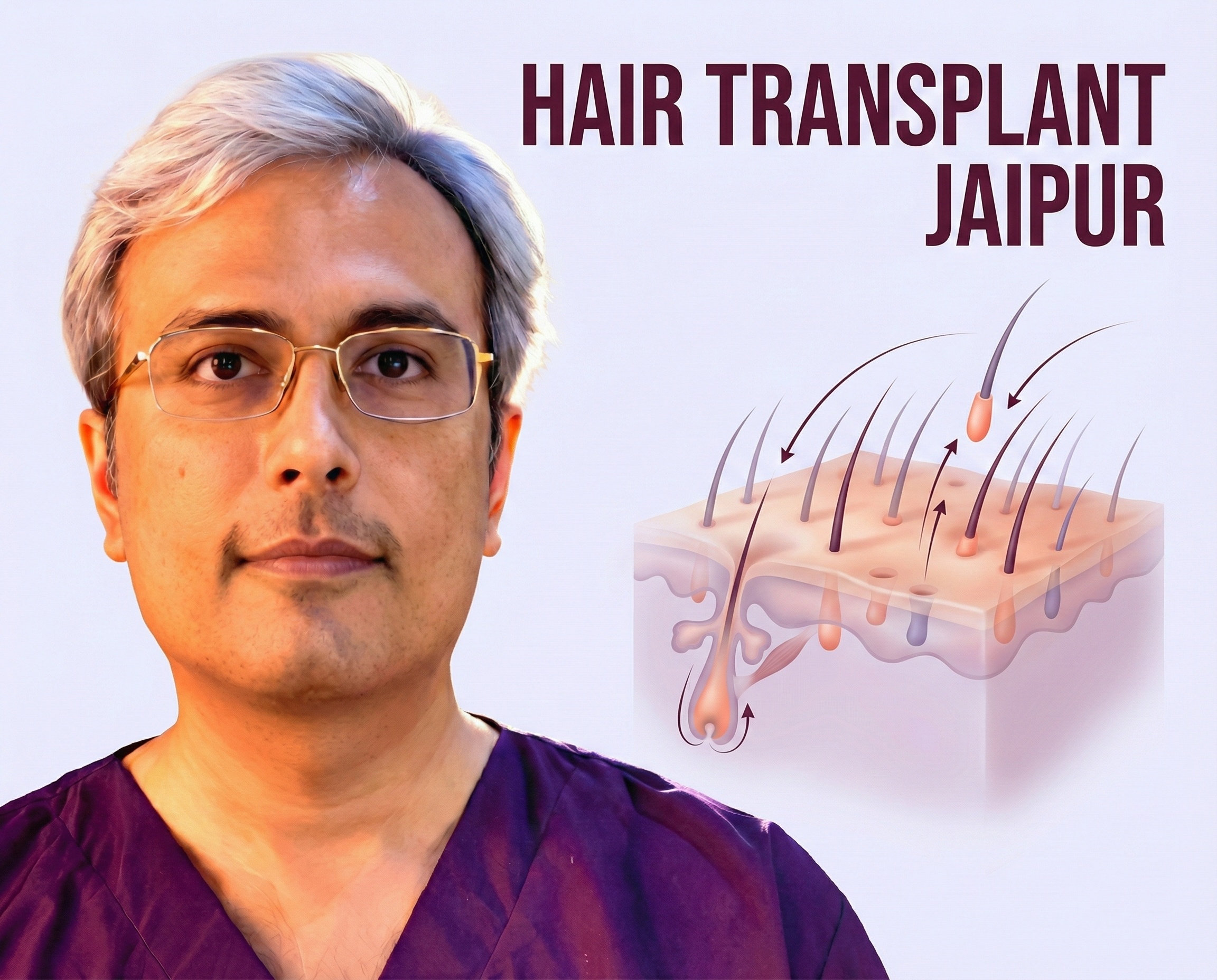As a plastic surgeon practising in Jaipur, one of the most common questions I hear from patients concerned about thinning hair is: “What exactly is a hair transplant, and can it really help me?” It’s a fair question, and the simple answer is yes, it can be a very effective solution for many.
Hair transplant surgery, also known as hair restoration or hair replacement, is a specialised surgical procedure. Its main goal is to help you overcome hair loss by carefully moving healthy hair follicles from one part of your body – usually an area where hair is still growing well – to the areas where your hair is thinning or has completely disappeared. Think of it as borrowing the best hair from one spot to make another spot look fuller and more natural.
We aim to give you back a head of hair that looks and feels like your own, permanently. This is achieved by taking hair follicles from what we call the “donor area” and transplanting them into the “recipient area” where you’ve experienced hair loss. The result is a more complete and natural-looking coverage.
This process is considered a minimally invasive surgical procedure. We utilise advanced techniques to ensure that the outcome is as natural as possible, giving you the confidence you deserve.
Why is This Procedure So Important for Hair Loss?
The reason hair transplant surgery is so important is that it addresses the root cause of hair loss in a permanent way. Unlike temporary solutions or treatments that might slow down hair loss, a hair transplant actually restores hair in the areas where it’s been lost.
Many people in India, and indeed around the world, experience hair loss, especially as they get older. This can be due to genetics, hormonal changes, or even stress. For many, thinning hair can significantly impact their self-esteem and how they feel about their appearance. Hair transplant surgery offers a tangible and lasting solution. It’s about more than just getting hair back; it’s about regaining a sense of youthfulness and confidence. We perform these procedures to provide a permanent solution for thinning hair or bald spots, aiming to restore a fuller look and boost your self-assurance.
How Do We Decide If a Hair Transplant is Right for You?
Determining if a hair transplant is the best option for you involves a thorough and personalised assessment. Think of it like building a house: before we start, we need to ensure the foundation is solid and that the design suits the land.
Our Approach to Assessment:
When you come in for a consultation here in Jaipur, my team and I will carefully evaluate your hair loss. We’ll look at several key factors:
- Your Hair Loss Pattern: We need to understand the extent and pattern of your hair loss. Is it thinning all over, or are there specific bald patches?
- The Health of Your Donor Area: This is crucial. We need to assess the density and quality of hair in your donor area, which is typically the back and sides of your scalp. This is where we’ll be harvesting the hair follicles.
- Your Overall Health: Like any surgery, your general health is important to ensure you’re a good candidate and will recover smoothly.
- Your Expectations: We’ll discuss what you hope to achieve with the procedure. It’s vital that your expectations are realistic, and we’ll guide you on what can be achieved.
A Simple Analogy:
Imagine you have a garden that’s become a bit bare in some spots. A hair transplant is like taking healthy plants from a well-watered part of your garden and replanting them in the bare patches. We need to make sure we have enough healthy plants (donor hair) to make the bare spots look full and natural. We also need to ensure the soil in the new spots (recipient areas) is ready to receive these plants.
Key Factors We Consider:
To help you understand what goes into this decision, here are the main things we look at:
- Type of Hair Loss: While hair transplantation is excellent for Androgenetic Alopecia (often called male or female pattern baldness), it may not be the best solution for all types of hair loss, such as those caused by medical conditions or certain medications. We’ll identify what’s causing your hair loss.
- Donor Hair Availability: The amount and quality of hair in your donor area directly influence how many grafts we can transplant and the density we can achieve. If the donor area is too thin, we might need to explore other options or manage expectations.
- Hair Colour and Texture: Sometimes, certain hair colours or textures can contribute to a more natural-looking result when transplanted.
- Age: While there’s no strict age limit, younger patients experiencing hair loss might benefit from a treatment plan that includes medication to manage the progression of hair loss alongside transplantation.
- Your Hairline Design: We’ll discuss how to design a natural-looking hairline that complements your facial features.
By carefully considering these factors, we can determine if a hair transplant is indeed the right path for you to achieve your hair restoration goals in Jaipur.
What are the Benefits for You as a Patient?
The benefits of a successful hair transplant go far beyond just having more hair. For our patients in Jaipur, it’s often about a significant boost in confidence and a more youthful appearance.
Here’s what you can expect:
- Permanent Hair Growth: The hair follicles we transplant are taken from areas of your scalp that are genetically programmed to grow hair throughout your life. This means the transplanted hair will continue to grow, just like your original hair, and won’t fall out due to the same causes of your initial hair loss. This leads to a long-lasting and natural-looking result.
- Natural Appearance: Modern techniques like Follicular Unit Extraction (FUE) allow us to transplant hair in its natural groupings, typically 1-4 hairs per follicle. This meticulous process ensures that the transplanted hair grows in a pattern that is indistinguishable from your native hair, creating a seamless and natural look.
- Boost in Self-Confidence: For many, hair loss can be a source of significant self-consciousness. Restoring a fuller head of hair can dramatically improve self-esteem, making you feel more confident in social and professional settings. This is perhaps the most profound benefit we see in our patients.
- Minimal Scarring (with FUE): The Follicular Unit Extraction (FUE) technique, which is widely used today, involves harvesting individual hair follicles. This method is minimally invasive and leaves only tiny, almost imperceptible dots in the donor area, which are easily hidden by existing hair.
In summary, the top benefits are:
- Long-Term, Permanent Hair Restoration
- A Natural-Looking and Undetectable Result
- A Significant Improvement in Self-Esteem and Appearance
How Does This Affect Your Surgical Journey?
Understanding the entire journey, from your first consultation to seeing the final results, is important. We’re committed to making this process as smooth and comfortable as possible for you here in Jaipur.
The Consultation: This is where our assessment happens. We’ll discuss your hair loss, examine your scalp, and talk about your goals. We’ll explain the different techniques, like FUE, and help you understand what to expect in terms of results and recovery. We’ll also address any concerns you might have.
The Procedure: Hair transplant surgery is typically performed under local anesthesia, meaning you’ll be awake but comfortable and won’t feel any pain. We use advanced techniques to ensure the procedure is as efficient and comfortable as possible. The duration of the surgery can vary depending on the number of grafts being transplanted, but we make sure you’re well cared for throughout. Our clinic in Jaipur is equipped with modern facilities to ensure your safety and comfort.
Recovery: After the procedure, you’ll have some minor discomfort and swelling, which is completely normal. The transplanted hairs will initially shed within the first few weeks, which is also a normal part of the process. New hair growth typically starts to become visible around 3-4 months after surgery. The full results, with the transplanted hair growing thicker and denser, usually become apparent within 6 to 12 months. We’ll provide you with detailed post-operative instructions to ensure optimal healing and hair growth. [Link to: A Patient’s Guide to Hair Transplant Recovery in Jaipur].
Ongoing Care: Sometimes, especially for conditions like Androgenetic Alopecia, we might recommend medications to help maintain the hair that wasn’t transplanted and to slow down any further loss. We’ll discuss this as part of your long-term plan.
We pride ourselves on maintaining high standards of care and safety in our Jaipur practice, ensuring that your surgical journey is a positive and successful one.
A hair transplant is a powerful solution for hair loss, offering a permanent and natural way to restore your hair and boost your confidence. By understanding the process, the techniques used, and what to expect, you can make an informed decision about whether this procedure is the right step for you. Our commitment is to provide you with the best possible care and results, tailored to your individual needs.
Your Next Step to Fuller Hair in Jaipur:
Ready to explore how a hair transplant can help you? We invite you to schedule a personalised consultation with our experienced plastic surgery team here in Jaipur. Let us assess your specific needs and discuss the best approach to achieving your hair restoration goals.
Call us today to book your appointment with Dr. Vishal Purohit: 7718183535
Frequently Asked Questions
How long does a hair transplant procedure take?
The duration varies based on the number of grafts needed, but it can range from 4 to 8 hours. We ensure you are comfortable throughout the process.
When will I see the results of my hair transplant?
You’ll start to see new hair growth about 3-4 months after the surgery. The full, natural-looking results typically appear within 6 to 12 months.
Is hair transplant surgery painful?
The procedure is performed under local anesthesia, so you won’t feel pain during the surgery. You might experience some mild discomfort or soreness after the anesthesia wears off, which can be managed with prescribed medication.
What is the difference between FUT and FUE hair transplant techniques?
FUT (Follicular Unit Transplantation) involves removing a strip of skin from the donor area and dissecting it into grafts. FUE (Follicular Unit Extraction) involves extracting individual hair follicles directly from the donor area using a small punch tool. FUE generally results in less visible scarring and a quicker recovery.
Can hair transplant surgery be used for all types of hair loss?
Hair transplantation is most effective for Androgenetic Alopecia (pattern baldness). While it can be used for other types of hair loss, we will assess your specific condition to determine if it’s the best option for you.
Will the transplanted hair look natural?
Yes, with modern techniques like FUE, we transplant hair in its natural groupings of 1-4 hairs. This allows for a very natural-looking hairline and density that is indistinguishable from your original hair.
Disclaimer: This article is intended for informational purposes only. It is not a substitute for professional medical advice, diagnosis, or treatment. Always seek the advice of Dr. Vishal Purohit or other qualified health providers with any questions you may have regarding a medical condition. Never disregard professional medical advice or delay in seeking it because of something you have read in this article.








